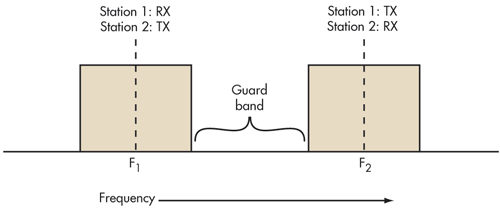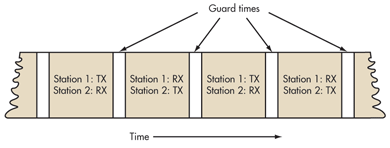Frequency Division vs. Time Division Duplexing in Wireless Communications
Frequency Division Duplex
FDD requires two separate wireless communications channels on separate frequencies, one for transmit and the other for received data.
FDD is used in the following wireless systems:
- Microwave (MW) Links
- Millimeter Wave (MMW) links
- Some 4G/LTE networks (some use TDD)
Wireless systems need two separate frequency bands or channels. A sufficient amount of guard band separates the two bands so the transmitter and receiver don’t interfere with one another. Good filtering or duplexers and possibly shielding are a must to ensure the transmitter does not desensitize the adjacent receiver.

2. FDD requires two symmetrical segments of spectrum for the uplink and downlink channels.
In a radio with a transmitter and receiver operating simultaneously within such close proximity, the receiver must filter out as much of the transmitter signal as possible. The greater the spectrum separation, the more effective the filters.
FDD uses lots of frequency spectrum, though, generally at least twice the spectrum needed by TDD. In addition, there must be adequate spectrum separation between the transmit and receive channels. These so-called guard bands aren’t useable, so they’re wasteful. Given the scarcity and expense of spectrum, these are real disadvantages.
However, FDD is very widely used in cellular telephone systems, such as the widely used GSM system. In some systems the 25-MHz band from 869 to 894 MHz is used as the downlink (DL) spectrum from the cell site tower to the handset, and the 25-MHz band from 824 to 849 MHz is used as the uplink (UL) spectrum from the handset to cell site.
Another disadvantage with FDD is the difficulty of using special antenna techniques like multiple-input multiple-output (MIMO) and beamforming. These technologies are a core part of the new Long-Term Evolution (LTE) 4G cell phone strategies for increasing data rates. It is difficult to make antenna bandwidths broad enough to cover both sets of spectrum. More complex dynamic tuning circuitry is required.
FDD also works on a cable where transmit and receive channels are given different parts of the cable spectrum, as in cable TV systems. Again, filters are used to keep the channels separate.
Time Division Duplex
TDD uses a single frequency band for both transmit and receive. Then it shares that band by assigning alternating time slots to transmit and receive operations. The information to be transmitted—whether it’s voice, video, or computer data—is in serial binary format. Each time slot may be 1 byte long or could be a frame of multiple bytes.
TDD is used in the following wireless systems:
- WiFi Networks
- Some 4G/LTE networks (some use FDD)

3. TDD alternates the transmission and reception of station data over time. Time slots may be variable in length.
Because of the high-speed nature of the data, the communicating parties cannot tell that the transmissions are intermittent. The transmissions are concurrent rather than simultaneous. For digital voice converted back to analog, no one can tell it isn’t full duplex.
In some TDD systems, the alternating time slots are of the same duration or have equal DL and UL times. However, the system doesn’t have to be 50/50 symmetrical. The system can be asymmetrical as required.
For instance, in Internet access, download times are usually much longer than upload times so more or fewer frame time slots are assigned as needed. Some TDD formats offer dynamic bandwidth allocation where time-slot numbers or durations are changed on the fly as required.
The real advantage of TDD is that it only needs a single channel of frequency spectrum. Furthermore, no spectrum-wasteful guard bands or channel separations are needed. The downside is that successful implementation of TDD needs a very precise timing and synchronization system at both the transmitter and receiver to make sure time slots don’t overlap or otherwise interfere with one another.
Timing is often synched to precise GPS-derived atomic clock standards. Guard times are also needed between time slots to prevent overlap. This time is generally equal to the send-receive turnaround time (transmit-receive switching time) and any transmission delays (latency) over the communications path.
Advantages / disadvantages of LTE TDD and LTE FDD for cellular communications
There are a number of the advantages and disadvantages of TDD and FDD that are of particular interest to mobile or cellular telecommunications operators. These are naturally reflected into LTE.
| COMPARISON OF TDD LTE AND FDD LTE DUPLEX FORMATS | ||
|---|---|---|
| PARAMETER | LTE-TDD | LTE-FDD |
| Paired spectrum | Does not require paired spectrum as both transmit and receive occur on the same channel | Requires paired spectrum with sufficient frequency separation to allow simultaneous transmission and reception |
| Hardware cost | Lower cost as no diplexer is needed to isolate the transmitter and receiver. As cost of the UEs is of major importance because of the vast numbers that are produced, this is a key aspect. | Diplexer is needed and cost is higher. |
| Channel reciprocity | Channel propagation is the same in both directions which enables transmit and receive to use on set of parameters | Channel characteristics different in both directions as a result of the use of different frequencies |
| UL / DL asymmetry | It is possible to dynamically change the UL and DL capacity ratio to match demand | UL / DL capacity determined by frequency allocation set out by the regulatory authorities. It is therefore not possible to make dynamic changes to match capacity. Regulatory changes would normally be required and capacity is normally allocated so that it is the same in either direction. |
| Guard period / guard band | Guard period required to ensure uplink and downlink transmissions do not clash. Large guard period will limit capacity. Larger guard period normally required if distances are increased to accommodate larger propagation times. | Guard band required to provide sufficient isolation between uplink and downlink. Large guard band does not impact capacity. |
| Discontinuous transmission | Discontinuous transmission is required to allow both uplink and downlink transmissions. This can degrade the performance of the RF power amplifier in the transmitter. | Continuous transmission is required. |
| Cross slot interference | Base stations need to be synchronised with respect to the uplink and downlink transmission times. If neighbouring base stations use different uplink and downlink assignments and share the same channel, then interference may occur between cells. | Not applicable |
Application Examples
- Terrestrial Microwave links use FDD
- Terrestrial Millimeter Wave links use FDD
- Most cell-phone systems use FDD
- LTE and 4G systems use FDD or TDD depending on band.
- WiFi and Bluetooth use TDD
- Most 5GHz P2P and P2MP radios use TDD
TDD has advantages on spectral efficiency when the up/down data path content is asymmetric. Examples are Internet Download, IPTV and CCTV which have data content predominantly in one direction.
Conclusion
Both FDD and TDD have benefits depending on the application. Existing industry standards and spectrum regulation rules will often impose which choice of FDD or TDD is used.
TDD appears often to be the better overall choice, but FDD is far more widely implemented because of prior frequency spectrum assignments and earlier technologies. FDD will continue to dominate the cellular business for now. Yet as spectrum becomes more costly and scarce, TDD will become more widely adopted as spectrum is reallocated and repurposed.

You must be logged in to post a comment.